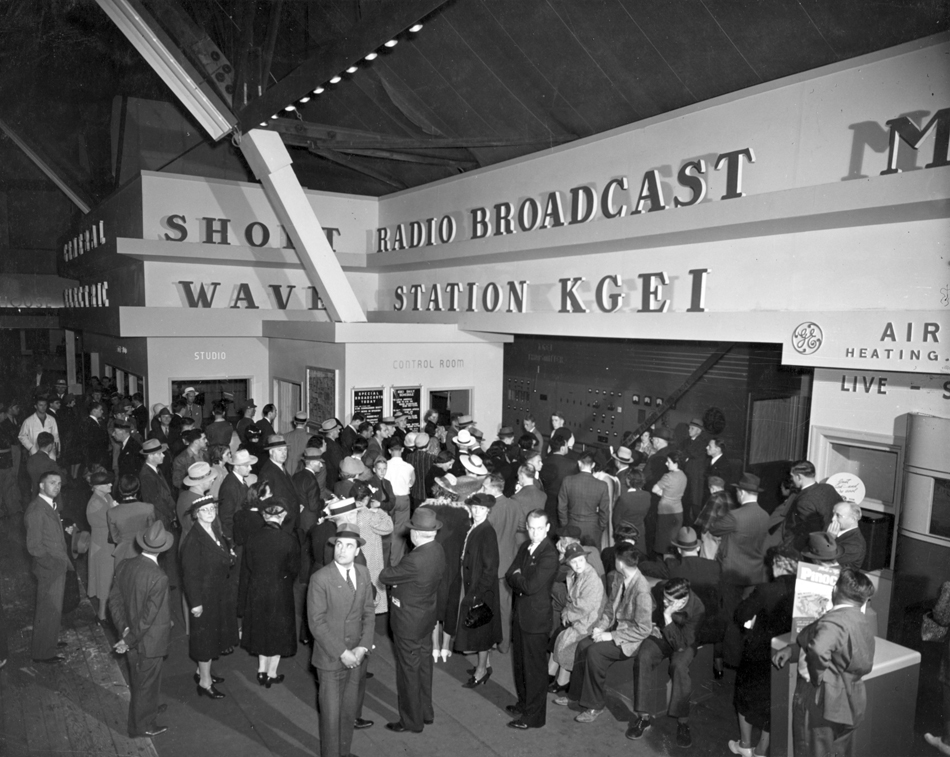
Photo courtesy of John Schneider and Bay Area Radio Museum. Used with permission.
Seventy five years ago, this date’s issue of Radio Guide magazine concluded a two-part feature on GE’s short wave station KGEI. Part 1 appeared in the August 31, 1940 issue, and part two appeared on September 7.
The station was owned and operated by General Electric and went on the air in San Francisco in March 1939. Short wave broadcasting was not new to GE. It first put a short wave signal on the air with station W2XAF in Schenectady, New York. That station later became WGEO. The next year, another transmitter was installed at the same site with call letters W2XAD, later WGEA. By 1940, WGEO was transmitting with 100,000 watts and was the world’s most powerful station. The two stations were popular with listeners in Europe and Latin America.

Golden Gate International Exposition, 1939-40. Wikipedia image.
By 1940, KGEI was running 20,000 watts, but there were plans to increase it to 50,000. The Schenectady stations operated on 9.53, 15.33, and 21.5 MHz. KGEI broadcast on 9.67 and 15.33 MHz, and provided an additional signal to Latin America as well as Asia and Oceania. The station, both studio and transmitter, was part of GE’s exhibit at the Golden Gate International Exposition, and was located on Treasure Island, between San Francisco and Oakland. The Island was also to serve as a terminus for Pan American‘s Clipper ships, and the station was used to promote Pan American as well as GE. According to the article, “one of the most interesting and colorful programs is ‘Clipper Departure.’ This program is a dockside complementary describing the actual departure of the China Clipper for Hawaii, Guam and points westward. The captain and various members of the crew of the Clipper are interviewed, each contributing some bit about the interesting aerial journeys to and fro across the Pacific. Passengers ready to embark give their reactions as they prepare to set forth on their fascinating trip. The program concludes with the roar of the Clipper’s motors as it moves down the ramp and into the bay off to Hawaii on the first leg of its voyage to Manila and Hong Kong.”
THe station had a studio on the Exposition grounds, and it also carried network programming, such as Burns and Allen, Bing Crosby, and the Don Ameche Show.

Photo courtesy of John Schneider and Bay Area Radio Museum. Used with permission.
The picture at the top of the page was taken in late 1939, and bears the KGEI call letters. The picture of the transmitter and enclosed studio at the left was taken earlier in the year and shows the W6XBE call sign. The public was allowed to be in the same room as the 50 kW transmitter, separated only by a flimsy guardrail.
After the Exposition, the station continued operation. During the War, it remained under GE’s control, but at the request of the Government, did carry programming that was recommended.
The station was widely listened to, especially in the Phillipines. Many resistance fighters listened to the station,, which included broadcast in Tagalog. In 1954-55, the station carried broadcasts from Stanford University, billed as “The International University of the Air.” During that period, the University received 12,000 letters from listeners in Latin America.
In 1960, the station was acquired by the Far East Broadcasting Company, a religious broadcaster. Even though FEBC operated other stations in Asia and the Pacific, KGEI was directed mostly to Latin America, billing itself as La Voz de la Amistad (The Voice of Friendship). During the 1962 Cuban Missile Crisis, the station once again put under Government control. In fact, a Cuban listener wrote to the station in 1962, and his letter included the exact positions and descriptions of Russian missile sites. This hadn’t been publicized in the world press yet, but KGEI decided to reproduce this interesting letter in one of its fundraising letters. Unbenknownst to KGEI, that mailing list included the CIA, which hastily arranged a meeting and asked that such letters be made available to them prior to making them public.
A few months later, presidential Press Secretary Pierre Salinger called and informed the station that the President was requesting use of the station to rebroadcast the VOA. The station was reluctant, since it valued its voice as being independent of the U.S. Government. But FEBC was eventually convinced of the need to “volunteer” the station, and it carried VOA programming during the crisis.
KGEI remained on the air until 1994. The original 50 kW GE transmitter was donated to another Christian organization organization for use in Liberia. However, it was destroyed by rebels prior to going on the air. The station’s then main transmitter, capable of 250 kW, was donated to another organization for use in broadcasting to Russia from Alaska.
Acknowledgment
I would like to thank John Schneider and the Bay Area Radio Museum for allowing me to use the photos shown on this page, and for providing much of the information for this post. More information about KGEI can be found on the Museum’s website.
References
Read More at Amazon
Click Here For Today’s Ripley’s Believe It Or Not Cartoon ![]()

Pingback: American Shortwave Broadcasting, 1941 | OneTubeRadio.com
Would you happen to know what broadcaster received the 250kw when FEBC turned it loose? Back in the mid-80’s, I enjoyed operating that transmitter while a FEBC engineer. As I recall, it was a one-of-a-kind grounded-grid monster that was water-cooled.
I don’t recall, but I would have gotten that information from one of the links at the end of the article. Since it was a religious shortwave broadcaster in Alaska, it was probably KNLS: https://en.wikipedia.org/wiki/KNLS
Thank you for your comments! I always enjoy hearing from people with a personal connection to these stories.
Pingback: WGEA and WGEO, Schenectady, NY, 1941 | OneTubeRadio.com
I led the crew that disassembled the 250,000 watt transmitter in 1995, which was donated to Calvary Chapel in Costa Mesa. It was never reassembled by them, was given to another ministry who took it to Alaska to transmit to Russia. I know that group had tremendous environmental issues with their antenna installation. The 50 KW transmitter was taken by another ministry to Liberia about the same time, and was subsequently destroyed by local rebels.
Pingback: Ying Ong, American Radio Patriot | OneTubeRadio.com
Pingback: GE Shortwave Stations, 1943 | OneTubeRadio.com